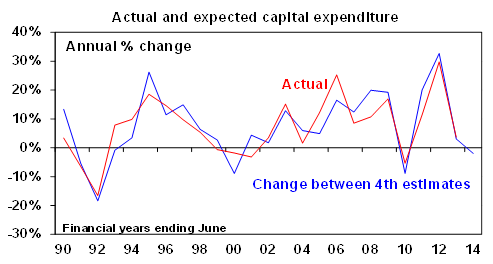Yesterday’s investment figures from the Australian Bureau of Statistics tells us that the mining services sector is facing further grief, on top of what they have experienced so far in the past year.
The figures were better than expected, both the actual spend in the quarter and the predicted spend in the rest of the year to June.
But this won’t help the mining services sector where companies are already being whacked by falling revenues, clients not paying on time, or paying slowly, and weak new business levels.
And for many companies involved in the construction phase, there are further problems as that investment by their clients slows, and the production and maintenance phases of many projects demand different, lower cost operators.
This in turn means more pressure for the sector for at least the next six months, and perhaps a bit more.
In fact the $60 million plus bailout of Forge Group yesterday by the ANZ Bank tells us the crisis in the services sector is intensifying, with more pain to come for any number of companies, large and small.
And the $31million quick capital raising by Ausenco and a new forecast plunge into the red, will only be the first of such announcements from the sector in coming months where downgrades are already the order of the day.
Companies such ALS, WorleyParsons, Ausdrill, Monadelpheous, Emeco, Transfield Services, NRW and Seven Group Holdings have downgraded earnings forecasts twice and more in the past year – and seen their share prices either crunched or weaken over time.
And some companies such as Boart Longyear are struggling to maintain an even keel, floats have been pulled with US private equity group KKR abandoning plans this week to float its local services company, Bis Industries with a value of $700 million or more.
Some of these companies will have to start moving into other sectors of the economy and look for work. But that’s where they will come up against the likes of Transfield Services, Leighton, UGL and other companies already there.
But Forge and Ausenco look like the biggest casualties to date, and judging by the investment data from the ABS, the pressure on the sector in the next year won’t go away quickly.
Investment in the economy generally was up 3.6% in the September quarter, but down 0.7% for the year to September 30. In the June quarter, total investment was up 4%, but down 2.3% in the 2012-13 financial year.
The market had been looking for a fall of 1.2% in the three months to September and bigger fall in the year. So the actual results were better than anyone had forecast.
And, forward estimates for the current financial year suggest a fall of 3% or more in overall investment in the year to June 30, 2014, but that is better than earlier forecasts this year.
Business investment better, but won’t help mining service companies immediately

BT Financial Group’s chief economist Chris Caton pointed out that spending in plant and equipment (which is concentrated in the mining sector) weakened in the September quarter.
Spending for equipment, plant and machinery fell 1.5% to $13.6 billion in the September quarter. It was 8.8% lower than the previous corresponding year, and the lowest since the last recession. He says that’s the lowest since the recession of the early 1990s.
And, the 4th estimate of investment for 2013-14 from the Australian Bureau of Statistics shows a 3% fall in mining investment over the rest of the financial year, with another 8% fall in spending on plant (but a small rise in spending on new buildings).
But the AMP’s chief economist Dr Shane Oliver said the investment figures were better than expected, both the actual spend in the quarter and the planned investment in coming months.
"Capex rose 3.6% in the September quarter which was well above market expectations for a 1.2% fall," he wrote yesterday.
"This was due to a 6.3% gain in construction (consistent with September quarter construction data already released) more than offsetting a 1.6% decline in equipment investment.
"The rise in investment was broad based across mining, manufacturing and “other selected industries”. It also adds to confidence that September quarter GDP growth will remain around 0.6% or so.
"More significantly though the capex expectations for 2013-14 were better than expected. There are two ways of interpreting this.
"Comparing the latest estimate for 2013-14, or what is called the 4th estimate, from the 4th estimate a year ago for 2012-13 shows a 2% decline, but this is up from an 11% decline when the third estimates were compared 3 months ago."
"In other words it still points to a decline in investment this financial year but only a small one.
"So yes, the capex data provides more confirmation that mining investment has peaked and manufacturing investment remains very poor, but the good news is that investment in what the ABS calls “other selected industries” looks like it’s starting to turn the corner.
"And the value of investment undertaken in the other industries category is six times bigger than that in manufacturing," Dr Oliver said.
One of the interesting small bits of investment was a 26% jump in planned spending by retailers. So much for the sector being down and out!













